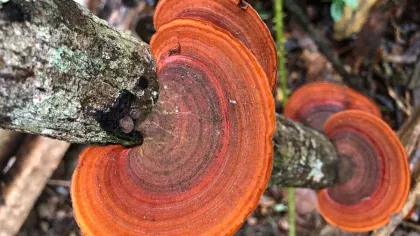28 March 2025
5 min read
Saving cloud forests: How rangers are protecting these threatened ecosystems
A conservation training course to enhance local skills to conserve cloud forests in the Dominican Republic

In the misty peaks of the Dominican Republic, where cool air clings to the trees and biodiversity flourishes, lies one of the most threatened ecosystems in the Caribbean: the Tropical Montane Cloud Forest. These forests, rich in endemic species, are vital for biodiversity and water regulation, yet they are disappearing at an alarming rate.
Despite these challenges, hope remains.
A new partnership between scientists at RBG Kew and local organisations is equipping forest rangers with additional skills to safeguard these precious landscapes. Though technically considered a small-scale conservation effort, the initiative - which is underpinned by seed conservation training - is proving to be a powerful tool for restoring and protecting the region’s cloud forests.
But what goes into saving a forest? Here we show you what’s involved in ensuring endemic species continue to thrive in the Dominican Republic.

Rangers: The guardians of local forest conservation
In November 2024, the Latin America Team of Kew’s Millennium Seed Bank Partnership (MSBP), alongside partners from Jardín Botánico Nacional (JBN), Fundación Moscoso Puello (FMP), and Fundación Progressio (FP), hosted a seed conservation training course aimed at training local forest rangers.
This initiative, funded by the British Embassy in Santo Domingo, aimed to enhance local capacity in collecting and conserving native tree seeds crucial for cloud forest restoration.
Conserving magnolia forests
This course supported a larger project to restore threatened Magnolia forests in the Dominican Republic as part of the Weston Global Tree Seed Bank Programme (GTSBP).
The project is focused on the conservation and use in restoration of tree species associated with the magnolia forests, as well as three endangered magnolia species:
- Magnolia domingensis
- Magnolia hamorii
- Magnolia pallescens

Rangers trained during the course are now integral to this mission. In Valle Nuevo National Park, they assist in monitoring and collecting seeds from endangered species like Podocarpus buchii and Juniperus gracilior, ensuring they are preserved and ready for reforestation efforts.
By working directly with scientists, these rangers are bridging the gap between conservation science and on-the-ground action.
The week-long training, held at the Reserva Científica Ébano Verde (REV) combined classroom learning with hands-on fieldwork. Rangers gained skills in identifying ripe seeds, using seed collecting techniques and understanding seed post-harvest management to maximise seed viability. This expertise will play a critical role in ensuring the successful propagation and conservation of threatened tree species.
A stormy start: Overcoming challenges
The training week began dramatically, with an unexpected storm rolling over the mountains drenching the reserve in heavy rain. But neither the weather nor the challenging conditions dampened our spirits. With some quick adjustments to the schedule, activities pressed on.
The week was officially inaugurated with an inspiring speech from Ing. Pedro Suárez, Director of the JBN, setting the tone for what would be a transformative experience for all involved. The Kew Team, composed of Michael Way and Silvia Bacci, started to explain the first modules of the course, followed by local partners who were responsible for different educational contents.

Getting hands-on in the forest
Each day of the training brought new challenges and discoveries. On the second day, rangers set out for their first field trip. Equipped with small secateurs and botanical lenses, they learned to assess seed ripeness through cut tests—an essential skill for ensuring long-term viability.
The following days saw rangers trek through the forest, encountering target species for conservation like Podocarpus buchii, a critically endangered cloud forest species. Unfortunately, the seeds had not yet reached the right stage of maturity for collection, but precise GPS coordinates were recorded to ensure the tree could be found again.


The collection of Brunellia comocladiifolia seeds, a pioneer tree species typical of cloud forests, proved particularly tricky due to the presence of small stinging hairs covering the fruits.
We also collected the seeds of Juniperus gracilior, another critically endangered tree species prioritised for conservation.


From Seed to Sapling: Restoring the Forest
A highlight of the training was a visit to the REV tree nursery managed by FP. Here, rangers witnessed first-hand the propagation of magnolia seedlings - a slow but vital process. Magnolias take up to two years to grow strong enough for reforestation, requiring careful nurturing in controlled conditions before being planted at restoration sites.

Once in the field, the seeds of Turpinia occidentalis were successfully gathered, followed by a meaningful group activity: planting Magnolia pallescens seedlings in a dedicated restoration site. This moment perfectly symbolised the essence of the training: taking the best steps towards rebuilding these threatened forests.


Strengthening Conservation Networks
Beyond technical training, the course fostered a lasting network among rangers, scientists, and conservationists. A dedicated WhatsApp group now connects trainees with experts, enabling real-time monitoring of seed maturity and facilitating rapid responses to environmental changes. This collaboration is crucial, especially as climate change alters plant phenology, shifting the timing of seed dispersal.

Looking Ahead: A Future for the Cloud Forests
As the Weston Project continues, efforts are underway to scale up conservation activities and further strengthen local expertise. With fieldwork trips planned for early 2025, rangers will continue playing a vital role in safeguarding these forests.
Small-scale conservation efforts, such as seed training for rangers, may seem like a drop in the ocean. However, as these local guardians gain the skills and knowledge to protect their forests, they become powerful agents of change. Thanks to the Weston GTSBP partnerships, the future looks brighter for the Dominican Republic’s cloud forests.
The Training course was possible thanks to funding from the British Embassy, Santo Domingo, with in-kind support from Dominican Republic partners, and RBG Kew, including one member of Kew project staff funded by the Garfield Weston Foundation.






